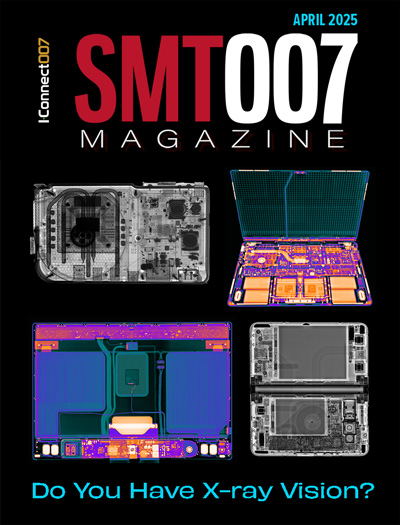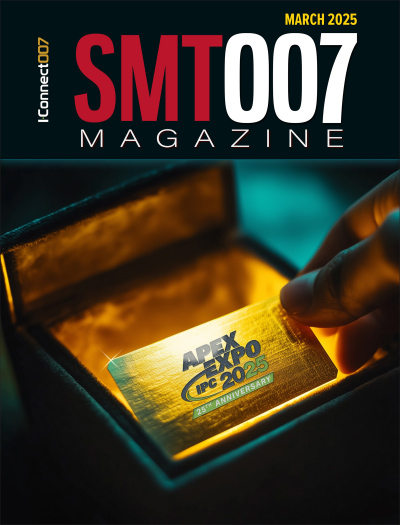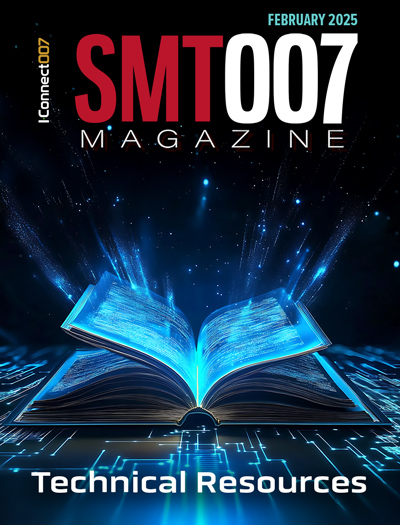-

- News
- Books
Featured Books
- smt007 Magazine
Latest Issues
Current Issue
Do You Have X-ray Vision?
Has X-ray’s time finally come in electronics manufacturing? Join us in this issue of SMT007 Magazine, where we answer this question and others to bring more efficiency to your bottom line.

IPC APEX EXPO 2025: A Preview
It’s that time again. If you’re going to Anaheim for IPC APEX EXPO 2025, we’ll see you there. In the meantime, consider this issue of SMT007 Magazine to be your golden ticket to planning the show.

Technical Resources
Key industry organizations–all with knowledge sharing as a part of their mission–share their technical repositories in this issue of SMT007 Magazine. Where can you find information critical to your work? Odds are, right here.
- Articles
- Columns
Search Console
- Links
- Media kit
||| MENU - smt007 Magazine
U.S. Navy Accepts Fifth Lockheed Martin-Built MUOS Satellite
November 21, 2017 | Lockheed MartinEstimated reading time: 2 minutes
The U.S. Navy's Communications Satellite Program Office, PMW 146, and Lockheed Martin handed over full operational control of the fifth Mobile User Objective System (MUOS) satellite to the Naval Satellite Operations Center (NAVSOC).
The October 11 milestone followed the successful completion of the MUOS-5 satellite's on-orbit testing and delivery of all operational products needed to "fly" the satellite. In April, the Navy, working with Army Forces Strategic Command (ARSTRAT), configured one of MUOS-5's two communications payloads – its legacy Ultra High Frequency (UHF) payload – for testing.
The handover of this satellite to NAVSOC clears the final hurdle allowing for ARSTRAT to provide the payload's final configurations to support the Navy's legacy UHF satellite communications mission.
"Today, every Combatant Command in aircraft, ships, submarines, ground vehicles, as well as by troops in the field and special operations, rely upon secure, beyond-line-of-sight UHF satellite communications provided by the Navy," said Mark Woempner, Lockheed Martin's director for Narrowband Communications. "ARSTRAT's final configuration of MUOS-5's UHF legacy payload allows the satellite to fully support our military forces in these Combatant Commands."
Eventually, legacy narrowband UHF communications will transition to next generation Wideband Code Division Multiple Access (WCDMA) capabilities. To facilitate that transition, all five on-orbit MUOS satellites were intentionally designed with two communications payloads to support both Legacy UHF and WCDMA.
Early combatant commander testing of the on-orbit WCDMA payloads began in July 2016. The new MUOS capabilities will revolutionize communications for mobile forces with simultaneous, crystal-clear voice, video and mission data over a secure high-speed Internet Protocol-based system. Users with new MUOS terminals will be able to seamlessly connect beyond line-of-sight around the world and into the Global Information Grid, as well as into the Defense Switched Network, as part of the Navy's worldwide cellular network.
Once fully operational, the MUOS network of five on-orbit satellites and four relay ground stations will provide more than 10 times the communications capacity of the legacy UHF satellite system. MUOS' network already provides near-global coverage, including communications into polar regions. MUOS also has demonstrated successful communication of Integrated Broadcast Service (IBS) messages.
"We continue to receive great and constructive feedback on MUOS' capabilities as more users try it out. Similar to a civilian cellular phone service, upgrades to this new secure global military cellular network are ground-based and designed in an AGILE software development environment. We continue to make upgrades to the system based on user needs and look forward to bringing its full capabilities to our warfighters," Woempner said.
Today there are more than 55,000 radio terminals currently fielded that can be upgraded to be MUOS-compatible, with many of them requiring just a software upgrade.
The Navy's Program Executive Office for Space Systems and its Communications Satellite Program Office responsible for the MUOS program are based in San Diego, California. Lockheed Martin assembled and tested all five now-on-orbit MUOS satellites at its Sunnyvale, California, facility.
About Lockheed Martin
Headquartered in Bethesda, Maryland, Lockheed Martin is a global security and aerospace company that employs approximately 97,000 people worldwide and is principally engaged in the research, design, development, manufacture, integration and sustainment of advanced technology systems, products and services.
For additional MUOS information, photos and video, click here.
Suggested Items
RTX's Collins Aerospace Enhances Capabilities to Speed Marine Corps Decision-making in Battle
04/22/2025 | RTXCollins Aerospace, an RTX business, successfully demonstrated new technology that helps the military gather and use information from a wider range of sources at Project Convergence Capstone 5, a large-scale military exercise.
AdvancedPCB Appoints Gary Stoffer as Chief Commercial Officer
04/18/2025 | PRNewswireAdvancedPCB is proud to announce the appointment of Gary Stoffer as its new Chief Commercial Officer (CCO). In this role, Stoffer will lead all sales, marketing, and commercial strategy initiatives as the company continues its mission to deliver cutting-edge PCB solutions to industries worldwide.
Real Time with... IPC APEX EXPO 2025: GreenSource's Growth and Future Developments
04/15/2025 | Real Time with...IPC APEX EXPOThings are looking bright for GreenSource. Michael Gleason shares an update on GreenSource's recent growth and upcoming changes. A recipient of a Defense Production Act Investment Program award, GreenSource is planning for new substrate capabilities. Current investments continue to enhance equipment and sustainability initiatives such as water quality. And their unique collaboration with the University of New Hampshire continues to aid their workforce development, despite recruitment challenges.
Apogee Semiconductor Teams with Arrow Electronics to Expand Distribution of Space-Grade Technologies
04/14/2025 | Apogee SemiconductorApogee Semiconductor, a leading provider of advanced technologies for space and extreme environments, announced its collaboration with Arrow Electronics, a global distributor of electronic components and services.
Satair, RTX’s Collins Aerospace Extend 50-year Relationship
04/14/2025 | Collins AerospaceSatair and Collins Aerospace, an RTX business, have signed a four-year extension of their cabin interior parts distribution agreement, continuing a relationship that has spanned more than 50 years.


